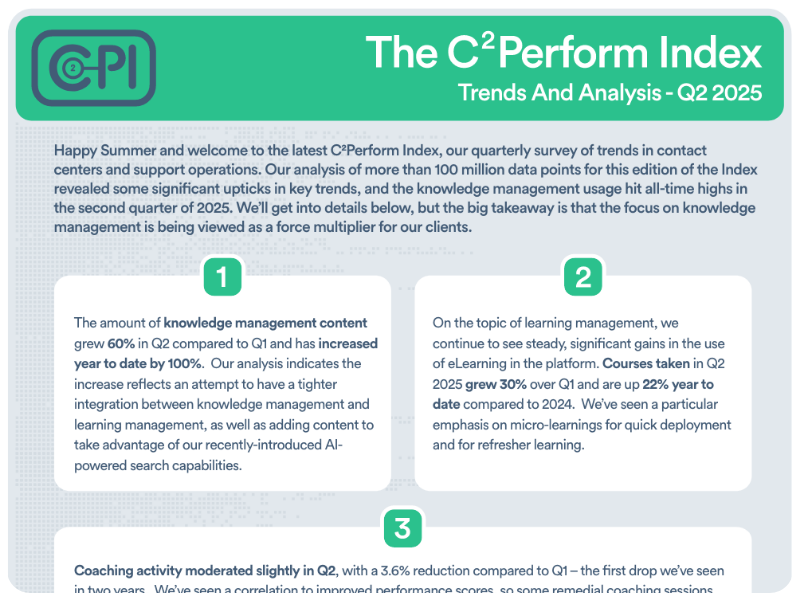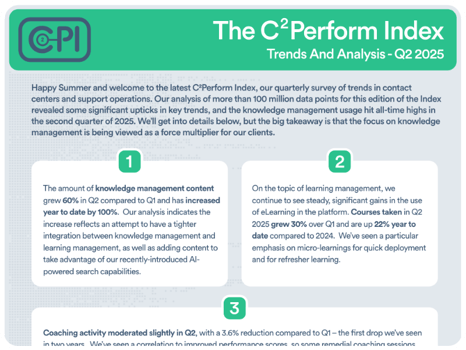Employee performance does not just impact their ability to meet performance goals. It can have an indirect impact on the company culture, leading employees to either become more or less engaged as they meet or miss their performance goals.
When numerous employees miss their goals, that can have a ripple effect. They may not feel like they’re being supported or given the tools they need.
Then, they can start to feel disengaged. Productivity continues to decline. The customer experience suffers. You run the risk of souring positive customer relationships, which can increase churn and damage your reputation.
One of the most common approaches to managing employee performance for employees who struggle to meet objectives is enrolling them into a performance improvement plan (PIP) — an approach that all too frequently falls short.
This is especially true in contact centers, where a PIP employee often views the plan as a final warning rather than a support system. In many cases, a poorly executed PIP call center process can push high-potential employees out the door.
What Is a Performance Improvement Plan (PIP)?
An employeeperformance improvement plan, or PIP, is a formal process that is used to help guide and support employees who are struggling with their job performance. The theory behind adopting this plan is for management to work closely with the employee on a regular basis to steer them in the right direction and more easily hit their performance goals.
However, the perception of PIPs on the employee level is frequently pessimistic. In many organizations, PIPs may be viewed negatively by employees because they are interpreted as a form of punishment or an indication that the employee will soon be let go instead of an opportunity to grow.
Although a PIP is meant to achieve a positive goal, it can often make employees feel more stressed and less motivated during their workday. This is just one of the many problems with PIPs that tend to do more harm than good.
When used incorrectly, a PIP in BPO settings can actually lower morale and productivity. That’s why implementing a call center agent performance improvement plan requires more than documentation — it demands engagement, coaching, and consistency.
Common Issues with PIPs for Employees
Managing employee performance is difficult, especially when team members start to struggle on a consistent basis. A common approach for contact center leaders is to implement performance improvement plans to try to help employees “course correct” so they can meet or beat their goals.
Yet PIPs often have the opposite effect of the desired outcome — many employees shut down and consider the plan as a warning sign of impending termination. There are many reasons why contact center employees may dislike or distrust performance improvement plans.
Especially in environments focused on customer service, like call centers, a traditional performance improvement plan customer service model can feel reactive and impersonal, when what agents often need is mentorship and role-specific guidance.
Here are some of the most common issues that we’ve seen employees voice about PIPs:
Lack of Objective Appraisal Criteria
One of the main issues with performance improvement plans is that they often lack clear and objective appraisal criteria to help employees understand what specific areas they need to focus on.
Without these critical details, employees may be left feeling confused or overwhelmed about their performance and how to improve it. This can lead to a decline in motivation and employee engagement, which further impacts their productivity and customer satisfaction.
It’s tough for a PIP employee who’s trying to do well but doesn’t have a clear target. When expectations are unclear or things keep changing, people get worn down. In a structured setting like a call center, that kind of confusion doesn’t just frustrate your team, but it leads to burnout, or worse, people leaving altogether. And that can negatively impact overall company financials even more than one or more employees who have been performing at suboptimal levels.
This has contributed to a higher rate of voluntary turnover in call centers. One that many of C2Perform’s customers have needed help addressing.
To avoid these pitfalls, contact center leaders need to invest in more effective performance management strategies that focus on open communication, coaching, and feedback. By providing employees with the one-on-one support they need to succeed in their roles, managers can help optimize employee performance and boost overall team morale and engagement.
Perceived Hypocrisy — "Do as I Say, Not as I Do"
Some team members may see PIPs as a hypocritical effort from management. This perception stems from the fact that it often seems as though management adopts these plans to manage poor or struggling employee performance, but then members of management teams fail to live up to those same standards themselves.
That double standard becomes even more noticeable in fast-paced environments like BPO organizations. A PIP in BPO settings can feel punitive when managers aren’t held to the same performance expectations or accountability processes. This lack of consistency leads to frustration and mistrust.
For example, managers may be quick to point out and criticize minor misbehaviors or errors made by their team members, but then fail to hold themselves accountable for the same type of behaviors. This can lead to feelings of resentment and distrust among employees because they feel as if they’re be disrespected and treated unfairly by management.
Contact center leaders need to work on improving communication and collaboration by modeling the behaviors they expect from their team members. By emphasizing transparency, consistency, and accountability in their own behavior, managers can help build trust and support within the team.
Overall, performance improvement plans are an important tool for contact center managers who are looking to improve employee performance. That entails "walking the walk" and demonstrating best practices as a leader.
Unclear Feedback
PIPs will often lack clear and actionable feedback about employee performance. Without action items outlined, employees are left to guess at what areas they need to improve or focus on and what they can do to actually improve, which can lead to confusion, frustration, and low motivation levels.
What’s more, these vague performance expectations may not be aligned with overall team or organizational goals, which can further undermine employee engagement and productivity levels.
Outside of PIPs, it’s important for contact centers to invest in more effective performance management strategies that focus on providing regular and clear feedback to employees. This can include establishing clear performance metrics and standards, as well as regularly measuring individual and team performance against these targets.
Additionally, managers should focus on providing specific, constructive feedback to help employees understand what they should prioritize and exactly what actions they need to take. This may require ongoing employee coaching and training, as well as regular opportunities for employees to share their thoughts and concerns about their performance.
Implied Personal Criticism and Humiliation
PIPs can often be perceived as humiliating, and some team members may be offended by critiques that seem like personal attacks. This is the effect of managers who approach PIPs in a punitive manner. Teams can read situations like that as bosses singling out specific employees, pushing all the blame on them instead of addressing specific issues within the culture or team operations.
In order to avoid this perception, managers need to approach performance improvement plans in a more collaborative and supportive manner. This can involve working with employees to identify issues or challenges that are impeding their performance, as well as providing additional training, coaching, and engagement tools that encourage employee recognition.
C2Perform has seen many customers significantly improve employee performance by providing recognition for outstanding performance and by increasing the number of one-on-one coaching sessions between employees and managers.
Stress from Threats
Many contact center employees may struggle with the increased pressure and expectations that come with a PIP, which can lead to feelings of stress and burnout. A perceived threat to their job security or career development rarely helps employees learn and implement positive behaviors.
Stress like that can work against everything a performance plan is meant to fix. If you’re a PIP employee, especially new to the role, the fear of failing can take over fast. In a busy PIP call center, where every number counts and coaching is hit or miss, that kind of pressure often leads to checking out instead of stepping up.
This stress comes from a lack of clarity that employees experience when they're engaging in a PIP. Unclear feedback and vague expectations can make this stress worse — reducing employee engagement and productivity.
To address this issue, contact center leaders from organizations that have partnered with C2Perform used the communication, reporting, and coaching tools to create more transparency and clarity around PIPs.
Alternatives to PIPs for Employees
In addition to addressing the issues with PIPs themselves, some contact center leaders may also want to consider alternative approaches for addressing employee performance.
One option is to build a call center agent performance improvement plan that shifts the mindset. Rather than trying to “fix” someone’s performance, it focuses on helping them move forward with clear coaching, practical goals, and support from their team.
For example, some managers have focused on increasing team and organizational accountability by setting clear goals and expectations. They then implemented regular performance reviews and feedback sessions that were consistent and frequent. This helped keep employees on track to meet the goals of their PIPs.
There are several types of technologies that managers can use to effectively improve employee performance in a more direct, measurable, and supportive way than a traditional PIP.
One popular technology is performance management software, which allows managers to track and monitor individual and team performance metrics over time. This can help leaders identify areas where employees may need additional support or training, as well as provide targeted feedback based on specific key performance indicators (KPIs).
For example, when helping your contact center agents improve their productivity, you can use quality assurance tools to track their progress on specific KPIs, like their time to resolution. These tools help organize specific data points and present real-time information related to an agent’s performance.
Other technologies that can be used to promote employee engagement and performance include tools for communication and collaboration, such as email and other integrated communication tools. These empower your team to connect with their peers, sharing helpful information and troubleshooting specific customer inquiries.
No matter what tools you use, success depends on how you implement them. Whether you're launching a formal PIP in BPO teams or trying to course-correct with lighter coaching frameworks, what matters most is clarity, empathy, and follow-through.
C2Perform offers an all-in-one performance management platform that empowers your managers to use effective performance improvement methods like to support their team at each step of the way to optimize their efforts.
Book a demo to see how C2Perform can help you improve employee performance the right way.
 English
English Español
Español





.png?height=350&name=Untitled%20(300%20x%20175%20px).png)



